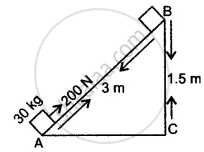Advertisements
Advertisements
प्रश्न
Can every force produce work?
उत्तर
APPEARS IN
संबंधित प्रश्न
A pair of bullocks exerts a force of 140 N on a plough. The field being ploughed is 15 m long. How much work is done in ploughing the length of the field?
Power spent by a body depends on the time for which it does work.
A coolie is moving on a road with a luggage on his head. Does he perform work against the force of gravity? Give reason for your answer.
State the energy transformation on the following:
Electricity is obtained from solar energy.
State the SI unit of work.
A max X goes to the top of a building by a vertical spiral staircase. Another man Y of the same mass goes to the top of the same building by a slanting ladder. Which of the two does more work against gravity and why?
What is the work done when the object acted upon by a force remains at rest?
What is the ratio of SI units to CGS units of 'work'?
Name the type of energy possessed by a
(i) stretched catapult (ii) hot iron
(iii) wound up clock
A cricket ball is thrown up from the earth's surface. What happens to its P.E.
(a) during the motion
(b) at the highest point?
Define the term work. Name the CGS and SI unit of work.
State the energy changes which take place when A piece of magnesium wire is burnt in a jar of oxygen.
A block of mass 30 kg is pulled up a slope, as shown in diagram with a constant speed, by applying a force of 200 N parallel to slope.
A and B are initial and final positions of block.

(i) Calculate the work done by force in moving the block from A to B.
(ii) Calculate P.E. gained by block. [g=10ms-2]
________ is said to be done when a force is acting on it.
A force of F = (5y + 20) `hat"j"` N acts on a particle. The work done by this force when the particle is moved from y = 0 m to y = 10 m is ______ J.
